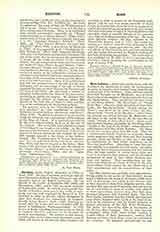

Hare Indians, a Dene tribe which shares with the Loucheux the distinction of being the northernmost Redskins in America, their habitat being immediately south of that of the Eskimos. Their territory extends from Fort Norman, on the Mackenzie, west of Great Bear Lake, to the confines of the Eskimos, not far from the Arctic Ocean. They are divided into five bands or sub-tribes, namely: the Nni-o’tinne, or “People of the Moss”, who rove along the outlet of Great Bear Lake; the Kra-tha-go’tinne, “People among the Hares”, who dwell on the same stream; the Kra-cho-go’tinne, “People of the Big Hares”, whose hunting grounds are inland, between the Mackenzie and the coast of the Arctic Ocean; the Sa-cho-thu-go ‘tinne, “People of Great Bear Lake”, whose name betrays their location, and lastly the Nne-lla-go’tinne, “People of the End of the World”, whose district is conterminous with that of the Eskimos. The Hares do not now number more than 600 souls. They are a timorous and kindly disposed set of people, whose innate gentleness long made them and their hunting grounds, bleak and desolate as they are, a fair field for exploitation by their bolder neighbors in the West and South-East. According to some this natural timidity is responsible for their name; but others apparently better informed contend that it is derived from the large number of Arctic hares (lepus arcticus) to be found in their country, and the aboriginal designation of some of their ethnic divisions confirms this opinion. Their medicine-men, or shamans, were formerly an object of dread to the sub-Arctic Denes, being famous for the effectiveness of their ministrations and the wonderfulness of their tricks.
The Hare Indians are naturally very superstitious. Owing partly to the nature of their habitat, dreary steppes which are the home of starvation much more than of abundance, and partly to the distance that at first separated them from religious centers, they retained their practice of abandoning and even eating the old and infirm in times of scarcity, and adhered to their superstitious customs, long after their more favored congeners had discarded them. The first Hare Indian admitted into the Church was baptized some fifteen hundred miles south of the land of his birth in the summer of 1839 by Father Belcourt, a famous missionary of the Red River Settlement. The Indian was then dying while in the employ of the Hudson Bay Company. But his tribe was not evangelized before 1859, when Father Grollier, a French Oblate of Mary Immaculate, reached Fort Norman and later Good Hope, where he established his residence. He labored unremittingly to win over the Hares, among whom he died, practically in the act of instructing them. Fathers Seguin and Petitot, of the same congregation, perfected his work, and the latter was the first minister of the Gospel to visit (1866) their lands on Great Bear Lake, and take the glad tidings to the tribal division that lived on its shore. Today the Hare Indians are almost all Catholics.
A. G. MORICE

